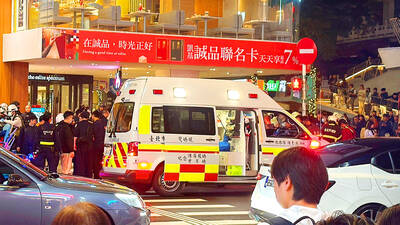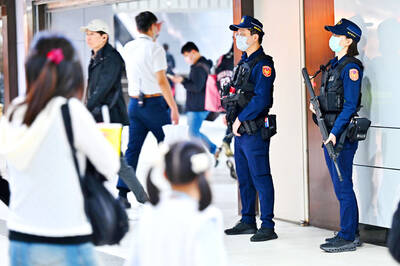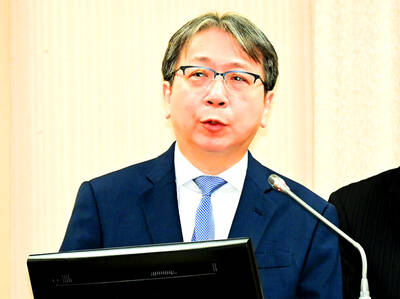Despite warming cross-strait ties, China has not relented on its military buildup and “may attempt a direct assault on Taiwan proper” when it has amassed enough amphibious transport vehicles or when the situation calls for it, according to this year’s Ministry of National Defense report on the military capability of the People’s Liberation Army (PLA).
The report, released on Friday, marked the first time that the ministry had mentioned the possibility of China making a direct assault on the nation in all the past estimates of PLA military capability.
According to the report’s analysis on the combat capability of the PLA and the threat it poses to Taiwan, the PLA as yet lacks sufficient amphibious transport boats in its regular army and does not have the capability to launch a general invasion of Taiwan.
Currently, China still relies on intimidation tactics, running blockades and the threat of artillery or missile bombardment as possible methods of answering hostile cross-strait situations, the report said.
However, the report said that with the continued upgrading of the PLA’s military equipment through arms purchases and research and development, the cross-strait military imbalance would only accelerate.
It added that the PLA’s growing investment in military equipment would also increase the difficulty of any foreign intervention in cross-strait affairs.
With China’s GDP growing nearly 10 percent from 1979 to 2008, and 9.2 percent just in the past year, the report says that China has become the second-largest economy in the world, providing a robust source of funding for national defense.
Since 1989, China’s national defense budget has been growing at a fixed two-digit figure every year and its national defense budge next year is to reach 670 billion yuan (US$105 billion), 67 billion yuan more than last year, equivalent to an increase of 11.2 percent, the report said.
Because China’s research and development, arms sales profits, arms purchases expenditure, national defense industry profits and its budget for the People’s Armed Police (PAP) are excluded from its national defense budget, it is estimated that the amount of unlisted military expenditure is between two and three times the published amount, the report said.
According to statistics in the report, the Chinese Military and its Second Artillery Corp — China’s strategic missile force — has 2.3 million soldiers and China is seeking to increase their mechanization and digitization.
China is also seeking to enhance coordination of its army and air force rapid assault capabilities and special forces combat capability, the report said, adding that China’s navy is also looking to develop a blue-water navy based around aircraft carrier task forces.
On its submarine forces, China’s self-built manned submersible Jiaolong (蛟龍) has also become the only manned submersible capable of reaching a depth exceeding 7,000m, the report said.
The People’s Liberation Army Air Force is also stepping up the modernization of its systems and integrating C4ISR — Command, Control, Communications, Computers, Intelligence, Surveillance and Reconnaissance — in the hopes of obtaining capability to breach and assume air superiority over the first island chain, the report said.
The first island chain is a concept first introduced amid the Cold War. The first island chain starts from the Japanese archipelagos, passes through the Diaoyutai Islands (釣魚台), Taiwan, the Philippines, Indonesia and Malaysia, and ends at the Malacca Strait.
China’s Second Artillery Corp has continued to deploy Intercontinental Ballistic Missiles (ICBM), and China has also achieved — after the US and Russia — technical capability of automated rendezvous and docking of spacecraft, the report said, adding China’s cyberwarfare forces have also grown under military and governmental support.
China’s military budget is second only to the US, the report said, adding that the speed and scale of China’s increase of its military capability poses a security threat.
China feels the unification of both sides of the Strait under one nation is a historical necessity and though appropriate military contacts and the setting up of confidence and security-building measures to officially end the at-war status between Taiwan and China can be discussed under the “one China” principle, China’s military is still building up to deter “Taiwanese independence,” the report said.

TRAGEDY STRIKES TAIPEI: The suspect died after falling off a building after he threw smoke grenades into Taipei Main Station and went on a killing spree in Zhongshan A 27-year-old suspect allegedly threw smoke grenades in Taipei Main Station and then proceeded to Zhongshan MRT Station in a random killing spree that resulted in the death of the suspect and two other civilians, and seven injured, including one in critical condition, as of press time last night. The suspect, identified as a man surnamed Chang Wen (張文), allegedly began the attack at Taipei Main Station, the Taipei Fire Department said, adding that it received a report at 5:24pm that smoke grenades had been thrown in the station. One man in his 50s was rushed to hospital after a cardiac arrest

SAFETY FIRST: Double the number of police were deployed at the Taipei Marathon, while other cities released plans to bolster public event safety Authorities across Taiwan have stepped up security measures ahead of Christmas and New Year events, following a knife and smoke bomb attack in Taipei on Friday that left four people dead and 11 injured. In a bid to prevent potential copycat incidents, police deployments have been expanded for large gatherings, transport hubs, and other crowded public spaces, according to official statements from police and city authorities. Taipei Mayor Chiang Wan-an (蔣萬安) said the city has “comprehensively raised security readiness” in crowded areas, increased police deployments with armed officers, and intensified patrols during weekends and nighttime hours. For large-scale events, security checkpoints and explosives

PUBLIC SAFETY: The premier said that security would be tightened in transport hubs, while President Lai commended the public for their bravery The government is to deploy more police, including rapid response units, in crowded public areas to ensure a swift response to any threats, President William Lai (賴清德) said yesterday after a knife attack killed three people and injured 11 in Taipei the previous day. Lai made the remarks following a briefing by the National Police Agency on the progress of the investigation, saying that the attack underscored the importance of cooperation in public security between the central and local governments. The attack unfolded in the early evening on Friday around Taipei Main Station’s M7 exit and later near the Taipei MRT’s Zhongshan

ON ALERT: Taiwan’s partners would issue warnings if China attempted to use Interpol to target Taiwanese, and the global body has mechanisms to prevent it, an official said China has stationed two to four people specializing in Taiwan affairs at its embassies in several democratic countries to monitor and harass Taiwanese, actions that the host nations would not tolerate, National Security Bureau (NSB) Director-General Tsai Ming-yen (蔡明彥) said yesterday. Tsai made the comments at a meeting of the legislature’s Foreign Affairs and National Defense Committee, which asked him and Minister of National Defense Wellington Koo (顧立雄) to report on potential conflicts in the Taiwan Strait and military preparedness. Democratic Progressive Party (DPP) Legislator Michelle Lin (林楚茵) expressed concern that Beijing has posted personnel from China’s Taiwan Affairs Office to its